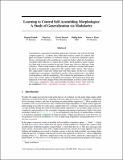| dc.contributor.author | Isola, Phillip John | |
| dc.date.accessioned | 2021-01-12T18:40:29Z | |
| dc.date.available | 2021-01-12T18:40:29Z | |
| dc.date.issued | 2019-12 | |
| dc.date.submitted | 2019-11 | |
| dc.identifier.issn | 1049-5258 | |
| dc.identifier.uri | https://hdl.handle.net/1721.1/129385 | |
| dc.description.abstract | Contemporary sensorimotor learning approaches typically start with an existing complex agent (e.g., a robotic arm), which they learn to control. In contrast, this paper investigates a modular co-evolution strategy: a collection of primitive agents learns to dynamically self-assemble into composite bodies while also learning to coordinate their behavior to control these bodies. Each primitive agent consists of a limb with a motor attached at one end. Limbs may choose to link up to form collectives. When a limb initiates a link-up action, and there is another limb nearby, the latter is magnetically connected to the 'parent' limb's motor. This forms a new single agent, which may further link with other agents. In this way, complex morphologies can emerge, controlled by a policy whose architecture is in explicit correspondence with the morphology. We evaluate the performance of these dynamic and modular agents in simulated environments. We demonstrate better generalization to test-time changes both in the environment, as well as in the structure of the agent, compared to static and monolithic baselines. Project video and code are available at https://pathak22.github.io/modular-assemblies/. | en_US |
| dc.language.iso | en | |
| dc.rights | Article is made available in accordance with the publisher's policy and may be subject to US copyright law. Please refer to the publisher's site for terms of use. | en_US |
| dc.source | Neural Information Processing Systems (NIPS) | en_US |
| dc.title | Learning to control self-assembling morphologies: A study of generalization via modularity | en_US |
| dc.type | Article | en_US |
| dc.identifier.citation | Pathak, Deepak et al. “Learning to control self-assembling morphologies: A study of generalization via modularity.” Advances in Neural Information Processing Systems, 32 (December 2019) © 2019 The Author(s) | en_US |
| dc.contributor.department | Massachusetts Institute of Technology. Department of Electrical Engineering and Computer Science | en_US |
| dc.relation.journal | Advances in Neural Information Processing Systems | en_US |
| dc.eprint.version | Final published version | en_US |
| dc.type.uri | http://purl.org/eprint/type/ConferencePaper | en_US |
| eprint.status | http://purl.org/eprint/status/NonPeerReviewed | en_US |
| dc.date.updated | 2020-12-18T18:26:06Z | |
| dspace.orderedauthors | Pathak, D; Lu, C; Darrell, T; Isola, P; Efros, AA | en_US |
| dspace.date.submission | 2020-12-18T18:26:10Z | |
| mit.journal.volume | 32 | en_US |
| mit.license | PUBLISHER_POLICY | |
| mit.metadata.status | Complete | |
